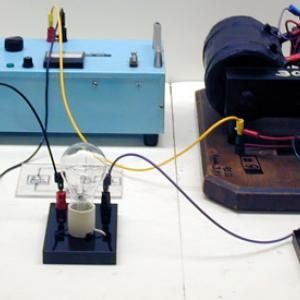College of Liberal Arts & Sciences
5J20.20 - Inductor Demo
Set the circuit up as shown in the circuit diagram. The 100 watt bulb goes in series with the power supply and inductor. The 25 watt light bulb is hooked across the inductor. Turn the power supply on and set to 90 of 100 volts. Press the key switch and observe the 25 watt light bulb come on right away and the 100 watt light bulb come on 1 to 2 seconds later. This is due to the large back EMF that the inductor has initially that shunts the voltage through the 25 watt light bulb. As the inductor increases its inductance it draws more voltage away from the light bulb and completes the circuit so the 100 watt bulb starts to glow. The light bulb wattages are picked purposely so that the 100 watt bulb will not come on until the inductor starts to work. Let off on the key and the 25 watt bulb will glow brightly momentarily as the inductor "kicks back" due to the falling magnetic field in the inductor.
An interesting variation is to replace the 25 watt bulb with a R2A neon bulb. One half of the neon electrode will light when the inductor circuit is closed and the other half of the electrode will light when the circuit is opened and the inductor "kicks back".
Another variation you can do with this demonstration is to use a 100 watt bulb in the series circuit as described above. In parallel with the series circuit place another 100 watt bulb and a 100 Ohm resistor (this is the resistance of the inductor in the series circuit). Now when you close the switch, you will get a time delay, both bulbs will be of equal brightness, but you will not get an EMF backflash.
Another demostration of the back EMF kick back of an inductor is to place the poles of the large electromagnet very close together. Hook up the Genecon generator and very quickly turn the handle about 20 times. Quickly release the handle and it will move in the opposite direction of the initial turn direction for several turns.
Coil: you crank the generator applying a torque. Again, because the generator acts like a motor it resists your efforts forcing you and to do work. You release the handle, the current keeps flowing in the same direction (Lenz's Law). This results in a torque in the same direction that registered your efforts origionally and the handle changes direction.
- Carl E. Mungan, "...And Hand-Cranked Induction", TPT, Vol. 52, #9, Dec. 2014, p. 518.
- Art Hovey, "Hand-Cranked Intuition", TPT, Vol. 52, #9, Dec. 2014, p. 518.
- N. Gauthier, "Relating the Stored Magnetic Energy of a Parallel-Plate Inductor to the Work of External Forces", TPT, Vol. 45, #8, Nov. 2007, p. 498.
- Melba Phillips, "Electromotive Force and Law of Induction", TPT, Vol. 1, #4, Oct. 1963, p.155.
- En-5: Freier and Anderson, A Demonstration Handbook for Physics.
- B-310: "Self-Induction Bulb", DICK and RAE Physics Demo Notebook.
- E-252: Richard Manliffe Sutton, Demonstration Experiments in Physics.
- E-12b: Wallace A. Hilton, Physics Demonstration Experiments.
Disclaimer: These demonstrations are provided only for illustrative use by persons affiliated with The University of Iowa and only under the direction of a trained instructor or physicist. The University of Iowa is not responsible for demonstrations performed by those using their own equipment or who choose to use this reference material for their own purpose. The demonstrations included here are within the public domain and can be found in materials contained in libraries, bookstores, and through electronic sources. Performing all or any portion of any of these demonstrations, with or without revisions not depicted here entails inherent risks. These risks include, without limitation, bodily injury (and possibly death), including risks to health that may be temporary or permanent and that may exacerbate a pre-existing medical condition; and property loss or damage. Anyone performing any part of these demonstrations, even with revisions, knowingly and voluntarily assumes all risks associated with them.

